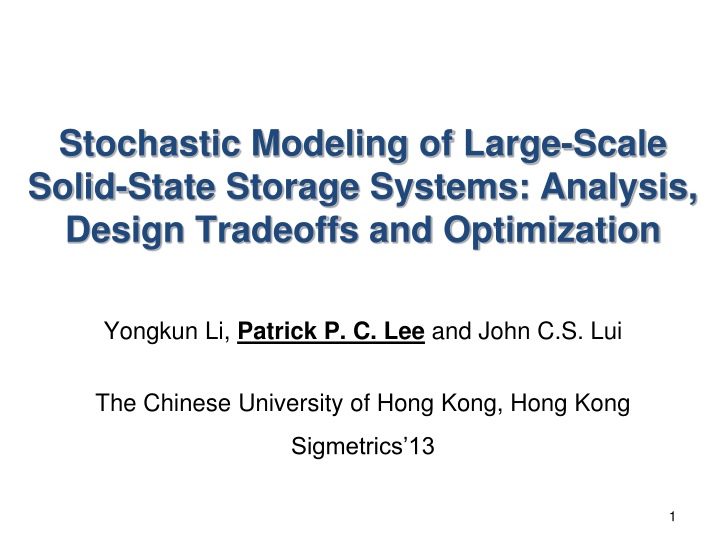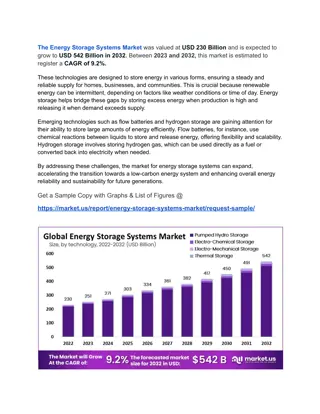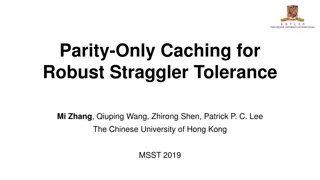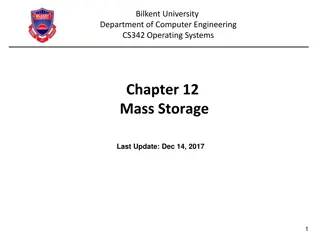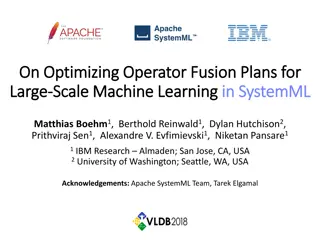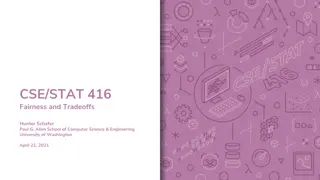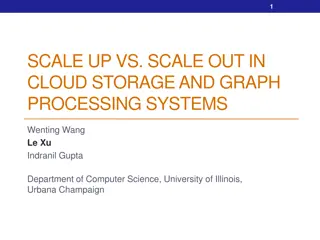Optimizing Tradeoffs in Large-Scale Solid-State Storage Systems
The research delves into stochastic modeling of Solid-State Storage Systems, emphasizing design tradeoffs and optimization strategies. Key aspects covered include the workings of SSDs, challenges such as wear-out, garbage collection, and tradeoff considerations between cleaning cost and wear-leveling. An analytical model and Markov model are proposed to analyze I/O dynamics and optimize system performance. The ultimate goal is to enhance durability, I/O throughput, and minimize write amplification in SSDs.
Download Presentation

Please find below an Image/Link to download the presentation.
The content on the website is provided AS IS for your information and personal use only. It may not be sold, licensed, or shared on other websites without obtaining consent from the author.If you encounter any issues during the download, it is possible that the publisher has removed the file from their server.
You are allowed to download the files provided on this website for personal or commercial use, subject to the condition that they are used lawfully. All files are the property of their respective owners.
The content on the website is provided AS IS for your information and personal use only. It may not be sold, licensed, or shared on other websites without obtaining consent from the author.
E N D
Presentation Transcript
Stochastic Modeling of Large-Scale Solid-State Storage Systems: Analysis, Design Tradeoffs and Optimization Yongkun Li, Patrick P. C. Lee and John C.S. Lui The Chinese University of Hong Kong, Hong Kong Sigmetrics 13 1
SSD Storage is Emerging Solid-state drives (SSDs) are widely adopted in data centers Examples: EMC XtremIO Array, NetApp Sandisk, Micron P420m Pros of SSDs: High I/O throughput, low power, high reliability EMC XtremIO [Source: http://www.crn.com] Cons of SSDs: Wear-out 2
How SSDs Work? Organized into blocks Each block has 64 or 128 pages of size 4KB each Three basic operations: read, write, erase Read, write: per-page basis Erase: per-block basis Out-of-place write for updates: Write to a clean page and mark it as valid Mark original page as invalid 3
How SSDs Work? Garbage collection (GC) needed to reclaim clean pages Choose a block to erase Move valid pages to another clean block Erase the block 2. erase 0 1 2 Block A Block A 1. write 0 2 Block B Block B Before GC After GC Challenges: Blocks can only be erased a finite number of times SLC: 100K; MLC: 10K; 3-bit MLC: several K to several hundred When a block reaches the limit, it wears out Bit error rates increase as blocks wear down 4
Motivation Design tradeoff of GC algorithms Minimizing cleaning cost reclaim the block with smallest number of valid pages improve I/O throughput and minimize write amplification Maximizing wear-leveling erase all blocks as evenly as possible improve durability Problems How to model the performance-durability tradeoff of GC algorithms? How to parameterize a GC algorithm to adapt to different tradeoff requirements? 5
Our Work Construct an analytical model that characterizes tradeoff between cleaning cost and wear-leveling for a general class of GC algorithms Develop a Markov model to characterize I/O dynamics Use mean-field analysis to derive asymptotic steady state Develop an optimization framework to analyze the tradeoff Propose a tunable GC algorithm which operates along the optimal tradeoff curve Conduct trace-driven simulations on DiskSim with SSD add-ons 6
Related Work on GC Empirical analysis: Agrawal et al. (USENIX ATC08) addressed tradeoff between cleaning cost and wear-leveling in GC Theoretical analysis on GC: focus on write amplification Hu et al. (SYSTOR09), Bux et al. (Performance10), Desnoyers (SYSTOR12): model different greedy algorithms on GC Benny Van Houdt (Sigmetrics13) also models write amplification of GC algorithms using mean field technique Our work analyzes performance tradeoff of different GC algorithms, with more general access pattern and address mapping; also conducts trace-driven simulations 7
Markov Model Consider an SSD containing ? physical blocks, each with ? pages Classify blocks into different types ??(?): type of block ? at time ? A block is of type ? iff it has ?valid pages (0 ? ?) 2 valid pages ??? = 2 0 1 2 Block ? System state: ??? = (?1? ,?2? , ,??(?)) Transformation: ??? = (?0? ,?1? , ,??(?)) ??? : number of type ? blocks at time ? 8
I/O Dynamics Read Does not change ??? GC Always reallocate valid pages to a new (clean) block Does not change ??? 2. erase Block A 0 1 2 Block A 1. write Block B Block B 0 2 Before GC After GC 9
I/O Dynamics Program (write data to flash) Changes a block from type ? to ? + 1 0 1 2 Before 0 1 2 3 After ??? = 3 ??? = 2 Invalidate (mark the data as invalid) Changes a block from type ? to ? 1 0 1 2 Before 0 1 2 After ??? = 1 ??? = 2 10
State Transition Only consider program and invalidate requests Arrive as a Poisson process with rate ? Uniform access pattern: each block has the same probability of being accessed probability of the requested page being invalidated is proportional to number of valid pages in the block State transition of a block What about the state transition of an SSD? 11
State Transition State space of ??? is huge Cardinality = ? + ? ? For 256GB SSD, ? 106,? = 64 huge state space! Resort to mean-field analysis to make the model tractable Occupancy measure ??? = (?0? ,?1? , ,??(?)) ??? =??(?) Stochastic process ?: fraction of type ? blocks at time ? 12
Mean Field Analysis Stochastic process ???converges to a deterministic process (mean field limit) ? ? = (?0? ,?1? , ,??(?)) as N is large ??(?): fraction of type ? blocks at time ? ODEs: Proof in technical report. 13
Steady-State Solution Deterministic process ? ? converges to a steady-state solution (fixed point) ? ? 2?, 0 ? ? (uniform case) ??= ? approximates the steady-state solution of the occupancy measure ??? The SSD contains ?? fraction of type ? blocks in steady state Proof in technical report. 14
General Access Pattern Define ??,? as the transition probability of a type ? block being transited to state ? for each request ODEs: Fixed point ? can be derived accordingly See our validation results in the paper 15
Performance Metrics Formalize GC algorithms Define ??as the weight of selecting a type ? block for each GC Constraint: ?=0 ? ? ?? ???? = ?=0 ????= 1 Prob. of choosing any type ? block Prob. of choosing a particular type ? block Performance metrics Cleaning cost: ? = ?=0 Average number of valid pages that are reallocated ? ????? 2 ?? ???? ?? ? ? ?=0 1 Wear-leveling: ? = ? 2?? = ?=0 ?? 2 ? ? ?=0 ??? How evenly each block is reclaimed 16
Tradeoff Analysis Maximizing wear-leveling 1 max ? = ?=0 ? 2?? ?? ? ?.?. ?=0 ????= 1, ?? 0. Solution ??= 1 for all ? ? = 1,? =? Choose every block with the same probability 1 Random algorithm 2(for uniform case) ? in each GC 17
Tradeoff Analysis Minimizing cleaning cost min ? = ?=0 ? ????? ? ?.?. ?=0 ????= 1, ?? 0. Solution ?0= 1 ?0, ??= 0 for all ? > 0 ? = 0,? = Choose the block with smallest number of valid pages in each GC Greedy algorithm 2? 0(for uniform case) 1 18
Tradeoff Analysis Optimal tradeoff Solution tradeoff Greedy algorithm minimizes cleaning cost Random algorithm maximizes wear-leveling 19
Randomized Greedy Algorithm Randomized Greedy Algorithm (RGA) Random step: Randomly choose ? (window size) blocks Greedy step: Choose the block that has the smallest number of valid pages among the ? blocks for GC If ? = 1: random algorithm If ? = ?: greedy algorithm Performance Cleaning cost: Wear-leveling: 20 MD Mitzenmacher, The Power of Two Choices in Randomized Load Balancing , 1996
Numerical Results Performance tradeoff Tradeoff indeed exists for GC algorithms RGA operates along the optimal tradeoff curve 21
Experimental Results Environment: DiskSim with SSD add-ons System configuration 32GB SSD with 8 flash chips, with 16,384 physical blocks each GC is performed independently in each chip Each block has 64 pages of size 4KB each 15% storage space preserved Threshold for triggering GC: free blocks less than 5% Datasets Financial, Webmail, Online and Webmail+Online Write intensive (around 80% write requests) 22
Cleaning Cost & Wear-leveling Greedy algorithm has the lowest cleaning cost and random algorithm achieves the highest wear-leveling RGA balances the tradeoff See our paper for I/O throughput and durability results 23
Summary Propose a stochastic model that characterizes tradeoff between cleaning cost (performance) and wear-leveling (durability) of GC algorithms in SSDs Random algorithm and greedy algorithm stand for the two extreme points in the tradeoff curve Propose a randomized greedy algorithm that operates on the optimal tradeoff curve Conduct extensive trace-driven simulations Future work: Hot/cold separation, address mapping, RAID reliability 24
